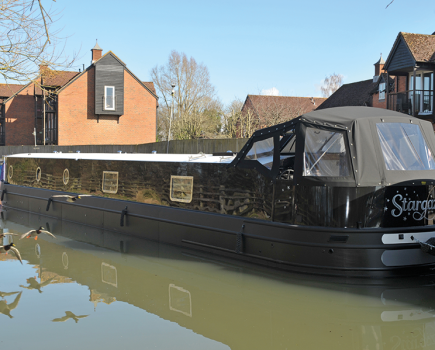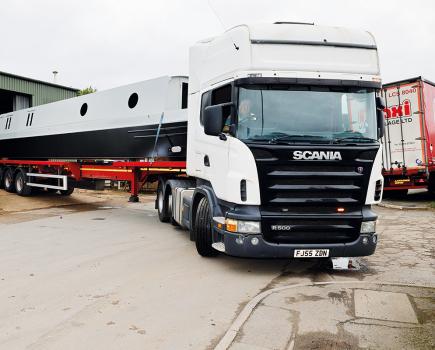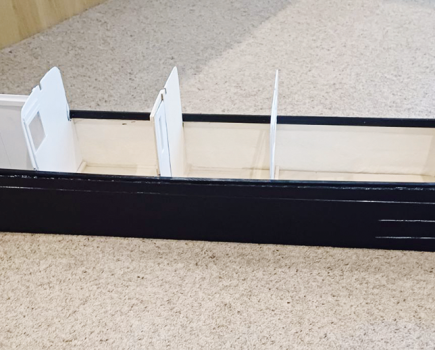When choosing who is going to build your new narrowboat it goes almost without saying that doing plenty of research is essential. The usual advice is to look at lots of boats and visit several builders before making up your mind.

But, just occasionally, the perfect match happens almost by accident – which is what happened to Ginny and Steve Morris. “We’d been to the Crick show and seen lots of boats,” says Steve. “But one day, after visiting our daughter at Loughborough University, we found ourselves at Market Harborough basin. We asked in the office if there were any boat-builders nearby and they suggested we visit Debdale Wharf Marina.”

Even then, it was only on their second visit to the marina that the couple met Russ Hubble and looked at a boat he had in build. “We immediately liked the quality of the work,” says Steve. “I work in building consultancy, so I have a lot of experience of joinery and this was some of the best we’d seen.”

Fast forward to the present, and Twelve & A Bit is the result. It’s a 57ft semi-trad, with a clutter-free interior dominated by clean lines and space; you could almost call it minimalist. It’s the sort of interior where good joinery is essential.



EXTERIOR


This boat is on a Colecraft shell, but Russ Hubble has specified a few changes from their standard. These include lowering the gunwales by a couple of inches which should give the boat a more settled look in the water. There are also scrolls on the cants and a few rivets at the bow and stern, both of which add a touch of interest.

The bow shape is recognisably Colecraft. While many boats start curving gently inwards at roughly the point where the cabin ends, this one leaves things much later. On the gunwales, the curve only properly gets going halfway along the well deck, while the rubbing strake keeps going straight ahead for even longer. From head on, the boat appears rather flared – a look emphasised by the white bow flashes. In addition, the slightly lowered gunwales mean there’s more of a rise.
All these factors combine to make the nose look shorter than it really is; the well deck and bow together are a fairly standard nine feet or so, but you’d swear it was nothing like that long. Below the rubbing strake, there’s just the hint of a Josher-inspired double curve – a semi-Josher, you might call it. There are also more rubbing strakes than usual to draw the eye towards the curves.
There’s a finger-grip along the handrail and fender eyes in the gunwales. There are lockers both sides of the well deck, while the bow thruster is in a watertight locker cross-ways. Together, they provide plentiful seating and there’s a neat fold-up table (which can also be used on the stern deck, where there’s more seating, or even inside on a specially built base).
There are two sets of front doors: the glazed oak doors which lead from the well deck can be covered by steel outer doors, to offer greater security. The windows are all double-glazed. The frames have a black powder coating, so they’re hardly visible against the dark blue paint. The colour scheme is simple but elegant, with maroon panels at the stern. The sign-writing, which is bold and fresh, is by Dean Box.
The level of thought that’s been applied to this boat is illustrated by the spring clips that hold the rear doors when they’re open. They’re strong, won’t break like cabin hooks often do and they can’t swing around to damage the paintwork.
LAYOUT AND FIT-OUT
This is a reverse layout boat. From the semi-trad stern there’s a small utility area, followed by the galley that includes a breakfast bar. The saloon is in the centre of the boat, with a through-shower room beyond. The cabin is at the bow.
The fit-out uses American white oak, and all the trim is solid wood. The floor is hardwearing Karndean, while the ceiling is painted white.
GALLEY
Three steps lead down from the rear deck and all have lifting treads to give plenty of storage space. There are cupboards either side: one is a wet locker, which has a finrad inside, to help dry coats. The other side is the electrical cupboard.
A breakfast bar with a couple of substantial stools provides a pleasant place to sit and eat. It forms the short side of an L-shaped run of galley units – and good use is made of the dead corner: the washing machine is located there, accessible from the breakfast bar side. Alongside there’s a slim under-gunwale can cupboard, so no space is wasted.
In the galley itself there’s plenty of storage and a 240-volt fridge is hidden behind a door. All the cupboards have pop-out knobs, so (assuming you remember to push them in again each time) there’s no danger of catching yourself on them. They contribute to a galley which is very sleek. Ginny and Steve Morris describe themselves as minimalists and wanted to maintain a spacious feel inside the boat. So it’s no surprise that there’s a smooth Corian worktop, with a large moulded sink and milled drainer. There are also no high level cupboards, although a full height unit contains an eye level Thetford oven and a microwave above (chosen to match the oven as closely as possible). All the switches throughout the boat are chrome.
On the opposite side there’s a smaller unit, with some clever features. To maintain the sleek look, there’s a pull-up stack of 240-volt sockets. At floor level, the kickboard has been turned into a wine rack, making use of what would otherwise be wasted space.
The radiator looks smart, but is in fact a fairly standard unit given a powder coating. There’s plenty of light thanks to a large window and a side hatch over the sink which has glazed panels.
SALOON
This is another area where the Morris’s minimalism shows itself. There’s relatively little in the way of fixed furniture.
The TV (a very smart, very, very thin LED model) is housed in a clever full height unit that appears much slimmer than it actually is – look in the cupboard below, though, and you’ll be surprised how deep it is. It contains a car radio and DVD player linked to speakers in the ceiling, storage space and a satellite box. But having to have the cupboard doors open to change the channel on the satellite system or switch radio channels wouldn’t be very minimal (some might even say it looked untidy) so there’s a ‘magic eye’ remote control sensor discreetly located above the TV. It means the doors can stay closed and the satellite box can stay out of sight.
If the floor of this boat feels unusually wide this is partly because the hull is square-sided, but also because there’s no boxing along the side. All the water and heating pipes are situated in what you might call a trench running the length of the boat. Junctions are carefully planned to coincide with cupboards so they can be accessed through panels in the base. The radiator pipes rise through shiny metal plates, which, if anything, emphasise the sense of space.
The stove is an Arrow Ecoburn and has a double insulated flue that should increase the draw and improve efficiency. Opposite there’s a small corner unit.
There are more glazed side hatches here too, while the windows have blinds. In true minimalist style, they’re held against the cabin sides when closed by magnets.
SHOWER ROOM
The shower room feels much more spacious than you’d expect, given that it takes up only five feet. The shower is an 800mm quadrant unit lined with laminate. Alongside, there’s an access panel for the shower pump.
The loo is a Jabsco macerator, with a remote holding tank under the bed. It’s on the centre line so it won’t affect the trim of the boat as it fills. Opposite is a corner unit with a Corian worktop and moulded basin; there’s a mirror above and cupboard underneath. Under the porthole there’s a heated towel rail. The doors at each side are pleasingly substantial, with proper door furniture and they’re held open by strong magnetic catches.
CABIN
This is a cabin with plenty of storage. There’s a full height wardrobe with double doors and more pop-out handles. A nice touch is a niche set into the side of the wardrobe for a cup or glass because this side of the bed doesn’t have a cabinet. The other side of the bed has a drawer unit. There’s more storage under the step up to the front deck as well as access to the water pump.
The cross-bed is one of the easiest to make up that we’ve encountered. At the foot there’s a substantial unit that houses not just a board to complete the base, but the bottom part of the mattress, too. The whole thing is beautifully balanced, so folding it down and back up again is almost effortless and there’s no need to wrestle with heavy sections of mattress.
There’s another powder-coated radiator (and the finish is very cheap to achieve, so there’s no excuse for a bog-standard white radiator), and more window blinds with magnets in the bottom.
TECHNICAL
Had this been a longer boat, Russ Hubble says he would have fitted a 24-volt system, which copes better with longer runs of cables. But as Twelve & A Bit is just 57ft, and will be a holiday boat rather than in constant use, he’s opted for the more standard 12 volts. The electrical cupboard was one of the neatest we’ve seen with properly regimented cables, rather than the bit of a bird’s nest we occasionally find.
There’s no shortage of power, with six 160Ah AGM batteries (plus engine and bow thruster batteries). There’s a 3kW Victron combi inverter and a shoreline can be connected either at the bow or stern, so it won’t matter which way around you moor in the marina. There’s an Adverc alternator controller to ensure the batteries charge efficiently and a Victron battery monitor so you know the state of the bank.
The boat is powered by the popular Beta 43, which should be a reliable option. The bow thruster is a 55kgf Vetus.
Heating is delivered by a Hurricane diesel boiler designed for the marine market. Steve Morris says a good heating system was high on their list of requirements because the couple enjoy winter cruising.
ON THE WATER
As you’d expect of a shell built by Colecraft, Twelve & A Bit handles well. It moves through the water nicely, turns well and is even pretty good in reverse (as demonstrated by backing into a berth at the far end of a four-boat-long pontoon).
The Beta 43 is quiet, vibration-free and gives plenty of power. The bow thruster is powerful enough – and its button is sensibly placed on the Morse control lever so you’ll never be scrabbling about trying to find it.
CONCLUSION
This is a boat with buckets of style and elegance. Outside, the shell has a pleasing shape and the paintwork is excellent. Inside, there are some clever uses of space (like the wine rack under the galley cupboards) and the absence of boxed-in pipes along the side of the boat makes it feel more spacious; it’s surprising how a few extra inches of width at floor level can make such a difference.
The price tag is £120,000 which is what you’d expect to pay for a bespoke boat of this quality. And it’s the quality of the joinery that makes this boat stand out: everything fits properly and there’s a clear attention to detail. That’s what really appealed to Ginny and Steve. So while it seemed as though owners and builders had stumbled across each other by accident, perhaps it was more like fate. After all, you can research boat-builders as much as you like, but the most important thing is finding one who can turn your ideas into reality. And that’s something you can only find out face to face – or maybe with a bit of luck or divine intervention.
Image(s) provided by:
Archant







